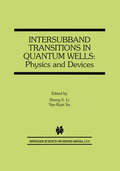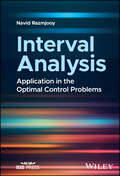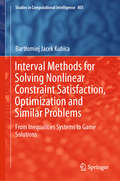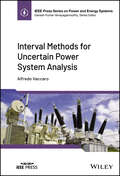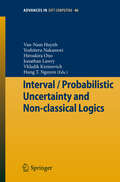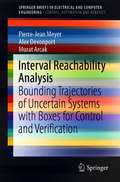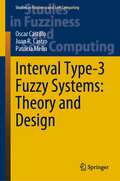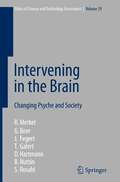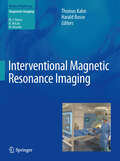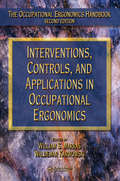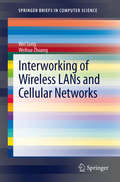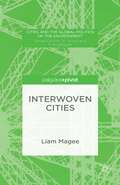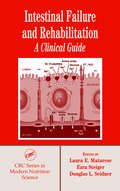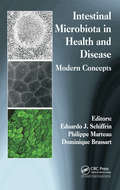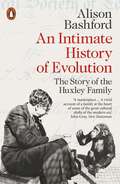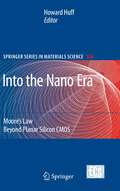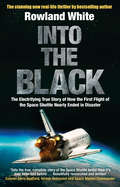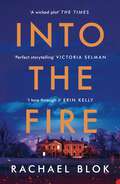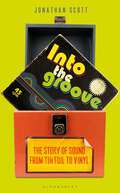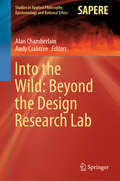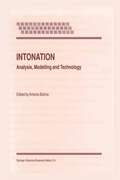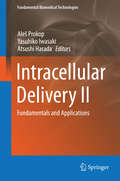- Table View
- List View
Intersubband Transitions in Quantum Wells: Physics and Devices
by Sheng S. Li Yan-Kuin Yan-Kuin SuThe International Workshop on "Intersubband Transitions in Quantum Wells:: Physics and Applications," was held at National Cheng Kung University, in Tainan, Taiwan, December 15-18, 1997. The objective of the Workshop is to facilitate the presentation and discussion of the recent results in theoretical, experimental, and applied aspects of intersubband transitions in quantum wells and dots. The program followed the tradition initiated at the 1991 conference in Cargese-France, the 1993 conference in Whistler, B. C. Canada, and the 1995 conference in Kibbutz Ginosar, Israel. Intersubband transitions in quantum wells and quantum dots have attracted considerable attention in recent years, mainly due to the promise of various applications in the mid- and far-infrared regions (2-30 J. lm). Over 40 invited and contributed papers were presented in this four-day workshop, with topics covered most aspects of the intersubband transition phenomena including: the basic intersubband transition processes, multiquantum well infrared photodetector (QWIP) physics, large format (640x480) GaAs QWIP (with 9. 0 J. lffi cutoff) focal plane arrays (FPAs) for IR imaging camera applications, infrared modulation, intersubband emission including mid- and long- wavelength quantum cascade (QC) lasers such as short (A. "" 3. 4 J. lm) and long (A. "" 11. 5 J. lm) wavelength room temperature QC lasers, quantum fountain intersubband laser at 15. 5 J. lm wavelength in GaAs/AIGaAs quantum well, harmonic generation and nonlinear effects, ultra-fast phenomena such as terahertz (THz) intersubband emission and detection. The book divides into five Chapters.
Interval Analysis: Application in the Optimal Control Problems (IEEE Press Series on Control Systems Theory and Applications)
by Navid RazmjooyInterval Analysis An innovative and unique application of interval analysis to optimal control problems In Interval Analysis: Application in the Optimal Control Problems, celebrated researcher and engineer Dr. Navid Razmjooy delivers an expert discussion of the uncertainties in the analysis of optimal control problems. In the book, Dr. Razmjooy uses an open-ended approach to solving optimal control problems with indefinite intervals. Utilizing an extended, Runge-Kutta method, the author demonstrates how to accelerate its speed with the piecewise function. You’ll find recursive methods used to achieve more compact answers, as well as how to solve optimal control problems using the interval Chebyshev’s function. The book also contains: A thorough introduction to common errors and mistakes, generating uncertainties in physical models Comprehensive explorations of the literature on the subject, including Hukurara’s derivatives Practical discussions of the interval analysis and its variants, including the classical (Minkowski) methods Complete treatments of existing control methods, including classic, conventional advanced, and robust control. Perfect for master’s and PhD students working on system uncertainties, Interval Analysis: Application in the Optimal Control Problems will also benefit researchers working in laboratories, universities, and research centers.
Interval Analysis: Application in the Optimal Control Problems (IEEE Press Series on Control Systems Theory and Applications)
by Navid RazmjooyInterval Analysis An innovative and unique application of interval analysis to optimal control problems In Interval Analysis: Application in the Optimal Control Problems, celebrated researcher and engineer Dr. Navid Razmjooy delivers an expert discussion of the uncertainties in the analysis of optimal control problems. In the book, Dr. Razmjooy uses an open-ended approach to solving optimal control problems with indefinite intervals. Utilizing an extended, Runge-Kutta method, the author demonstrates how to accelerate its speed with the piecewise function. You’ll find recursive methods used to achieve more compact answers, as well as how to solve optimal control problems using the interval Chebyshev’s function. The book also contains: A thorough introduction to common errors and mistakes, generating uncertainties in physical models Comprehensive explorations of the literature on the subject, including Hukurara’s derivatives Practical discussions of the interval analysis and its variants, including the classical (Minkowski) methods Complete treatments of existing control methods, including classic, conventional advanced, and robust control. Perfect for master’s and PhD students working on system uncertainties, Interval Analysis: Application in the Optimal Control Problems will also benefit researchers working in laboratories, universities, and research centers.
Interval Methods for Solving Nonlinear Constraint Satisfaction, Optimization and Similar Problems: From Inequalities Systems to Game Solutions (Studies in Computational Intelligence #805)
by Bartłomiej Jacek KubicaThis book highlights recent research on interval methods for solving nonlinear constraint satisfaction, optimization and similar problems. Further, it presents a comprehensive survey of applications in various branches of robotics, artificial intelligence systems, economics, control theory, dynamical systems theory, and others. Three appendices, on the notation, representation of numbers used as intervals’ endpoints, and sample implementations of the interval data type in several programming languages, round out the coverage.
Interval Methods for Uncertain Power System Analysis (IEEE Press Series on Power and Energy Systems)
by Alfredo VaccaroInterval Methods for Uncertain Power System Analysis In Interval Methods for Uncertain Power System Analysis, accomplished engineer Dr. Alfredo Vaccaro delivers a comprehensive discussion of the mathematical foundations of range analysis and its application to solving traditional power system operation problems in the presence of strong and correlated uncertainties. The book explores highly relevant topics in the area, from interval methods for uncertainty representation and management to a variety of application examples. The author offers readers the latest methodological breakthroughs and roadmaps to implementing the mathematics discussed within, as well as best practices commonly employed across the industry. Interval Methods for Uncertain Power System Analysis includes examinations of linear and non-linear equations, as well as: A thorough introduction to reliable computing, including discussions of interval arithmetic and interval-based operators Comprehensive explorations of uncertain power flow analysis, including discussions of problem formulation and sources of uncertainty in power flow analysis In-depth examinations of uncertain optimal power flow analysis Fulsome discussions of uncertain small signal stability analysis, including treatments of how to compute eigenvalues of uncertain matrices Perfect for engineers working in power flow and optimal power flow analyses, optimization theory, and computer aided simulation, Interval Methods for Uncertain Power System Analysis will also earn a place in the libraries of researchers and graduate students studying decision making under uncertainty in power systems operation.
Interval Methods for Uncertain Power System Analysis (IEEE Press Series on Power and Energy Systems)
by Alfredo VaccaroInterval Methods for Uncertain Power System Analysis In Interval Methods for Uncertain Power System Analysis, accomplished engineer Dr. Alfredo Vaccaro delivers a comprehensive discussion of the mathematical foundations of range analysis and its application to solving traditional power system operation problems in the presence of strong and correlated uncertainties. The book explores highly relevant topics in the area, from interval methods for uncertainty representation and management to a variety of application examples. The author offers readers the latest methodological breakthroughs and roadmaps to implementing the mathematics discussed within, as well as best practices commonly employed across the industry. Interval Methods for Uncertain Power System Analysis includes examinations of linear and non-linear equations, as well as: A thorough introduction to reliable computing, including discussions of interval arithmetic and interval-based operators Comprehensive explorations of uncertain power flow analysis, including discussions of problem formulation and sources of uncertainty in power flow analysis In-depth examinations of uncertain optimal power flow analysis Fulsome discussions of uncertain small signal stability analysis, including treatments of how to compute eigenvalues of uncertain matrices Perfect for engineers working in power flow and optimal power flow analyses, optimization theory, and computer aided simulation, Interval Methods for Uncertain Power System Analysis will also earn a place in the libraries of researchers and graduate students studying decision making under uncertainty in power systems operation.
Interval / Probabilistic Uncertainty and Non-classical Logics (Advances in Intelligent and Soft Computing #46)
by Jonathan Lawry Vladik Kreinovich Hung T. Nguyen Van-Nam Huynh Yoshiteru Nakamori Hiroakira OnoThis book contains the proceedings of the first International Workshop on Interval/Probabilistic Uncertainty and Non Classical Logics, Ishikawa, Japan, March 25-28, 2008. The workshop brought together researchers working on interval and probabilistic uncertainty and on non-classical logics. It is hoped this workshop will lead to a boost in the much-needed collaboration between the uncertainty analysis and non-classical logic communities, and thus, to better processing of uncertainty.
Interval Reachability Analysis: Bounding Trajectories of Uncertain Systems with Boxes for Control and Verification (SpringerBriefs in Electrical and Computer Engineering)
by Pierre-Jean Meyer Alex Devonport Murat ArcakThis brief presents a suite of computationally efficient methods for bounding trajectories of dynamical systems with multi-dimensional intervals, or ‘boxes’. It explains the importance of bounding trajectories for evaluating the robustness of systems in the face of parametric uncertainty, and for verification or control synthesis problems with respect to safety and reachability properties. The methods presented make use of: interval analysis; monotonicity theory; contraction theory; and data-driven techniques that sample trajectories. The methods are implemented in an accompanying open-source Toolbox for Interval Reachability Analysis. This brief provides a tutorial description of each method, focusing on the requirements and trade-offs relevant to the user, requiring only basic background on dynamical systems. The second part of the brief describes applications of interval reachability analysis. This makes the brief of interest to a wide range of academic researchers, graduate students, and practising engineers in the field of control and verification.
Interval Type-3 Fuzzy Systems: Theory and Design (Studies in Fuzziness and Soft Computing #418)
by Oscar Castillo Juan R. Castro Patricia MelinThis book briefly reviews the basic concepts of type-2 fuzzy systems and then describes the proposed definitions for interval type-3 fuzzy sets and relations, also interval type-3 inference and systems. The use of type-2 fuzzy systems has become widespread in the leading economy sectors, especially in industrial and application areas, such as services, health, defense, and so on. However, recently the use of interval type-3 fuzzy systems has been receiving increasing attention and some successful applications have been developed in the last year. These issues were taken into consideration for this book, as we did realize that there was a need to offer the main theoretical concepts of type-3 fuzzy logic, as well as methods to design, develop and implement the type-3 fuzzy systems. A review of basic concepts and their use in the design and implementation of interval type-3 fuzzy systems, which are relatively new models of uncertainty and imprecision, are presented. The main focus of this work is based on the basic reasons of the need for interval type-3 fuzzy systems in different areas of application. In addition, we describe methods for designing interval type-3 fuzzy systems and illustrate this with some examples and simulations.
Intervening in the Brain: Changing Psyche and Society (Ethics of Science and Technology Assessment #29)
by Reinhard Merkel G. Boer J. Fegert T. Galert D. Hartmann B. Nuttin S. RosahlThe wealth of insights into the brain’s functioning gained by neuroscience in recent years led to the development of new possibilities for intervening in the brain such as neurotransplantation, neural prostheses and brain stimulation techniques. Moreover, new and safer classes of psychopharmaceutical drugs lend themselves to neuroenhancement applications, i.e. they could be used to enhance cognitive capacities or emotional well-being without therapeutic need. This book offers extensive state-of-the-art accounts for these novel kinds of intervention, indicates future developments, and discusses the relevant philosophical, ethical and legal issues.
Interventional Magnetic Resonance Imaging (Medical Radiology)
by Thomas Kahn and Harald BusseThe idea of using the enormous potential of magnetic resonance imaging (MRI) not only for diagnostic but also for interventional purposes may seem obvious, but it took major efforts by engineers, physicists, and clinicians to come up with dedicated interventional techniques and scanners, and improvements are still ongoing. Since the inception of interventional MRI in the mid-1990s, the numbers of settings, techniques, and clinical applications have increased dramatically. This state of the art book covers all aspects of interventional MRI. The more technical contributions offer an overview of the fundamental ideas and concepts and present the available instrumentation. The richly illustrated clinical contributions, ranging from MRI-guided biopsies to completely MRI-controlled therapies in various body regions, provide detailed information on established and emerging applications and identify future trends and challenges.
Interventions, Controls, and Applications in Occupational Ergonomics
by William S. Marras Waldemar KarwowskiCompletely revised and updated, taking the scientific rigor to a whole new level, the second edition of the Occupational Ergonomics Handbook is now available in two volumes. This new organization demonstrates the enormous amount of advances that have occurred in the field since the publication of the first edition. The editors have brought together
Interworking of Wireless LANs and Cellular Networks (SpringerBriefs in Computer Science)
by Wei Song Weihua ZhuangThe next-generation of wireless communications are envisioned to be supported by heterogeneous networks by using various wireless access technologies. The popular cellular networks and wireless local area networks (WLANs) present perfectly complementary characteristics in terms of service capacity, mobility support, and quality-of-service (QoS) provisioning. The cellular/WLAN interworking is an effective way to promote the evolution of wireless networks. Interworking of Wireless LANs and Cellular Networks focuses on three aspects, namely access selection, call admission control and load sharing to investigate heterogeneous interworking for cellular/WLAN integrated networks. It not only reveals important observations but also offers useful tools for performance evaluation. The unique traffic and network characteristics are exploited to enhance interworking effectiveness. Theoretical analysis and simulation validation demonstrate benefits of cellular/WLAN interworking in real networks. Last but not the least, this brief highlights promising future research directions to guide interested readers.
Interwoven Cities (Cities and the Global Politics of the Environment)
by Liam MageeProposing a renovation of the metaphor of the urban fabric, Interwoven Cities develops an analysis of how cities might be woven into alternative patterns, to better sustain social and ecological life.
Intestinal Failure and Rehabilitation: A Clinical Guide
by Laura E. Matarese Ezra Steiger Douglas L. SeidnerThe introduction of parenteral nutrition support has given patients with short bowel syndrome the time they need to achieve maximal intestinal rehabilitation and has allowed these patients to survive. The pioneering work of Drs. Byrnes and Wilmore in the 1990s focused on novel techniques to enhance intestinal adaptation and absorption, including mo
Intestinal Microbiota in Health and Disease: Modern Concepts
by Eduardo J. Schiffrin Dominique Brassart Philippe MarteauNow considered an organ with defensive and metabolic capabilities, the intestinal microbiota plays a major role in the local host immune system development and education. It contributes to the generation of a homeostatic balance characterized by the capacity to react against pathogens while remaining hyperresponsive/tolerant against commensals. Thi
An Intimate History of Evolution: The Story of the Huxley Family
by Alison Bashford'A masterpiece of biography ... a vivid account of a family at the heart of some of the great cultural shifts of the modern era' John Gray, New Statesman'The whole of British intellectual life seems accessible through some branch of this sprawling family tree' The GuardianIn his early twenties, poor, racked with depression, stranded in the Coral Sea on the seemingly endless survey mission of HMS Rattlesnake, hopelessly in love with the young Englishwoman Henrietta Heathorn, Thomas Henry Huxley was a nobody. And yet together he and Henrietta would return to London and go on to found one of the great intellectual and scientific dynasties of their age.The Huxley family through four generations profoundly shaped how we all see ourselves. In innumerable fields observing both nature and culture, they worked as scientists, novelists, mystics, film-makers, poets and - perhaps above all - as public lecturers, educators and explainers.Their speciality was evolution in all its forms - at the grandest level of species, deep time, the Earth, and at the most personal and intimate. They shaped great organizations - the Natural History Museum, Imperial College, the London Zoo, UNESCO, the World Wildlife Fund - and they shaped fundamentally how we see ourselves, as individuals and as a species, one among many.But perhaps their greatest subject was themselves. Alison Bashford's marvellously engaging and original new book interweaves the Huxleys' momentous public achievements with their private triumphs and tragedies. The result is the history of a family, but also a history of humanity grappling with its place in nature. This book shows how much we owe - for better or worse - to the unceasing curiosity, self-absorption and enthusiasms of a small, strange group of men and women.'This is history with the engaging intimacy of a novel. Bashford brilliantly marries intellectual history with the story of four generations in a literary tour de force' Professor Jim Secord, author of Visions of Science
Into The Nano Era: Moore's Law Beyond Planar Silicon CMOS (Springer Series in Materials Science #106)
by Howard HuffEven as we tentatively enter the nanotechnology era, we are now encountering the 50th anniversary of the invention of the IC. Will silicon continue to be the pre-eminent material and will Moore’s Law continue unabated, albeit in a broader economic venue, in the nanotechnology era? This monograph addresses these issues by a re-examination of the scientific and technological foundations of the micro-electronics era. It also features two visionary articles of Nobel laureates.
Into the Black: The electrifying true story of how the first flight of the Space Shuttle nearly ended in disaster
by Rowland WhiteOn 12th April 1981 a revolutionary new spacecraft blasted off from Florida on her maiden flight. NASA’s Space Shuttle Columbia was the most advanced flying machine ever built – the high watermark of post-war aviation development. A direct descendant of the record-breaking X-planes the likes of which Chuck Yeager had tested in the skies over the Mojave Desert, Columbia was a winged rocket plane, the size of an airliner, capable of flying to space and back before being made ready to fly again. She was the world’s first real spaceship.On board were men with the Right Stuff. The Shuttle’s Commander, moonwalker John Young, was already a veteran of five spaceflights. Alongside him, Pilot Bob Crippen was making his first, but Crip, taken in by the space agency after the cancellation of a top secret military space station programme in 1969, had worked on the Shuttle’s development for a decade. Never before had a crew been so well prepared for their mission.Yet less than an hour after Young and Crippen’s spectacular departure from the Cape it was clear that all was not well. Tiles designed to protect Columbia from the blowtorch burn of re-entry were missing from the heatshield. If the damage to their ship was too great the astronauts would be unable to return safely to earth. But neither they nor mission control possessed any way of knowing. Instead, NASA turned to the National Reconnaissance Office, a spy agency hidden deep inside the Pentagon whose very existence was classified. To help, the NRO would attempt something that had never been done before. Success would require skill, pinpoint timing and luck …Drawing on brand new interviews with astronauts and engineers, archive material and newly declassified documents, Rowland White, bestselling author of Vulcan 607, has pieced together the dramatic untold story of the mission for the first time. Into the Black is a thrilling race against time; a gripping high stakes cold-war story, and a celebration of a beyond the state-of-the-art machine that, hailed as one of the seven new wonders of the world, rekindled our passion for spaceflight.*With a foreword by Astronaut Richard Truly*‘Beautifully researched and written, Into the Black tells the true, complete story of the Space Shuttle better than it’s ever been told before.’ Colonel Chris Hadfield, former Astronaut and Space Station Commander‘Brilliantly revealed, Into the Black is the finely tuned true story of the first flight of the Space Shuttle Columbia. Rowland White has magnificently laid bare the unknown dangers and unseen hazards of that first mission … Once read, not forgotten.’Clive Cussler
Into the Fire
by Rachael Blok'I tore through it' Erin Kelly 'Perfect storytelling' Victoria Selman 'A wicked plot' The Times Eleven guests. Three nights. One murderer.In a stately mansion in the Hertfordshire countryside, sisters Lois and Ebba throw a launch party for their new venture: Archipelago, a virtual reality game.In attendance are their celebrity investors including a glamorous British couple, a brooding Swedish financier, a Dutch banker and his film star wife, and a controversial politician.But beneath the glamorous surface, there are sordid secrets that include steamy affairs, deals in dirty money and anonymous death threats. So when eight of the guests are involved in a helicopter crash, it quickly becomes clear that it was no accident. It was murder.'Sizzles with suspense' Jane Isaac 'Gripping and beautifully told' Clare Empson 'Held me in a tight grip' Caroline Green 'Intelligent, modern and richly textured' Dominic Nolan
Into the Groove: The Story of Sound From Tin Foil to Vinyl
by Jonathan ScottThe story of recorded sound – the technological developments, the people that made them happen and the impact they had on society – from the earliest inventions via the phonograph to LPs, EPs and the recent resurgence of vinyl.While Thomas Edison's phonograph, the first device that could both record and reproduce sound, represented an important turning point in the story of recorded sound, it was really only the tip of the iceberg, and came after decades of invention, tinkering and experiment. Into the Groove tells the story of the birth of recorded sound, from the earliest serious attempts in the 1850s all the way up to the vinyl resurgence we're currently enjoying. This book celebrates the ingenuity, rivalries and science of the modulated groove.Vinyl collector and music buff Jonathan Scott dissects a mind-blowing feat that we all take for granted today – the domestication of sound. He examines the first attempts to record and reproduce sounds, the origin of the phonograph, and the development of commercial shellac discs. Later he moves through the fascinating story of the LP record, from the rise of electric recording to the fall of 7-inch vinyl, the competing speed and format wars, and an epilogue that takes the story up to the present-day return of vinyl to vogue. Into the Groove is the story of the science of sound – the technological developments, the humans that made them happen and the impact they had on society. It uncovers tales of intrigue and betrayal, court battles and lesser-known names who are often left out of most histories. Read this book, and find a new appreciation of the not-so-simple black disc that holds a special place in the history of music and sound.
Into the Groove: The Story of Sound From Tin Foil to Vinyl
by Jonathan ScottThe story of recorded sound – the technological developments, the people that made them happen and the impact they had on society – from the earliest inventions via the phonograph to LPs, EPs and the recent resurgence of vinyl.While Thomas Edison's phonograph, the first device that could both record and reproduce sound, represented an important turning point in the story of recorded sound, it was really only the tip of the iceberg, and came after decades of invention, tinkering and experiment. Into the Groove tells the story of the birth of recorded sound, from the earliest serious attempts in the 1850s all the way up to the vinyl resurgence we're currently enjoying. This book celebrates the ingenuity, rivalries and science of the modulated groove.Vinyl collector and music buff Jonathan Scott dissects a mind-blowing feat that we all take for granted today – the domestication of sound. He examines the first attempts to record and reproduce sounds, the origin of the phonograph, and the development of commercial shellac discs. Later he moves through the fascinating story of the LP record, from the rise of electric recording to the fall of 7-inch vinyl, the competing speed and format wars, and an epilogue that takes the story up to the present-day return of vinyl to vogue. Into the Groove is the story of the science of sound – the technological developments, the humans that made them happen and the impact they had on society. It uncovers tales of intrigue and betrayal, court battles and lesser-known names who are often left out of most histories. Read this book, and find a new appreciation of the not-so-simple black disc that holds a special place in the history of music and sound.
Into the Wild: Beyond the Design Research Lab (Studies in Applied Philosophy, Epistemology and Rational Ethics #48)
by Alan Chamberlain Andy CrabtreeThis edited collection opens up new intellectual territories and articulates the ways in which academics are theorising and practicing new forms of research in ‘wild’ contexts. Many researchers are choosing to leave the familiarity of their laboratory-based settings in order to pursue in-situ studies ‘in the wild’ that can help them to better understand the implications of their work in real-world settings. This has naturally led to ethical, philosophical and practical reappraisals with regard to the taken for granted lab-based modus operandi of scientific, cultural and design-based ways of working. This evolving movement has led to a series of critical debates opening up around the nature of research in the wild, but up until now these debates have not been drawn together in a coherent way that could be useful in an academic context. The book brings together applied, methodological and theoretical perspectives relating to this subject area, and provides a platform and a source of reference material for researchers, students and academics to base their work on. Cutting across multiple disciplines relating to philosophy, sociology, ethnography, design, human–computer interaction, science, history and critical theory, this timely collection appeals to a broad range of academics in varying fields of research.
Intonation: Analysis, Modelling and Technology (Text, Speech and Language Technology #15)
by Antonis BotinisANTONIS BOTINIS 1. 1 Background This introduction provides essential information about the structure and the objects of study of this volume. Following the introduction, fourteen papers which represent current research on intonation are organised into five thematic sections: (I) Overview of Intonation, (II) Prominence and Focus, (III) Boundaries and Discourse, (IV) Intonation Modelling, and (V) Intonation Technology. Within the sections the papers are arranged thematically, although several papers which deal with various aspects of intonation and prosody are basically intersectional. As the title indicates, "Intonation: Analysis, Modelling and Technology" is a contribution to the study of prosody, with major emphasis on intonation. Intonation and tonal themes are thus the central object of the volume, although temporal and dynamic aspects are also taken into consideration by a good number of papers. Although tonal and prosodic distinctions have been dealt with throughout man's literate history with reference to the study of language, for example by classical philosophers such as Plato and Aristotle, it is in recent decades that we have witnessed the most fertile growth in intonation studies, as with experimental phonetics and speech technology in general. As Rossi (this volume) points out, intonation research really began to blossom in the sixties with a multi fold increase in prosodic studies, reflected in contributions to the International Congress of Phonetic Sciences (ICPhS), and in the international literature.
Intracellular Delivery II: Fundamentals and Applications (Fundamental Biomedical Technologies #7)
by Aleš Prokop Yasuhiko Iwasaki Atsushi HaradaThis volume is a continuation of Volume 1 following the previously published Editorial. More emphasis is given to novel nanocarrier designs, their characterization and function, and applications for drug discovery and treatment. A number of chapters will deal with nanofibers as a new major application within the biomedical field with a very high success rate particularly in wound healing and diabetic foot and spine injuries. A major new subdivision will deal with mathematical methods for the assembly of nanocarriers both for simulation and function.
